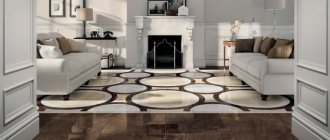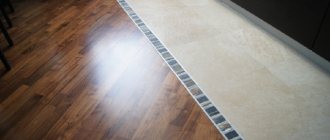Why choose floor tiles
Interior tiles produced by manufacturers are suitable for decorating walls, floors and even ceilings, but at the same time they differ in performance qualities. Home owners are faced with a difficult choice before the upcoming renovation, which depends on the drafted project.
When choosing flooring, many choose tiles for the living room floor
, considering that the use of such materials has undeniable advantages:
- extended service life if care recommendations are followed
- high level of resistance to mechanical stress and abrasion
- a huge selection of colors, sizes and shapes, materials of manufacture
It cannot be said that certain types of floor tiles have only advantages; such coatings also have disadvantages. For example, ceramic tiles can be cold and to neutralize this disadvantage, you can use floor heating systems to avoid discomfort.
Another nuance is that the surface of the coating is too smooth; tiles with a glossy finish are quite slippery, so your choice must be taken as carefully as possible.
Color palette
Since the range of ceramic coatings on the modern market is wide, the choice of color scheme in the living room depends only on the taste of its owner.
- For connoisseurs of bright interiors, white, gray, beige tiles for floors and walls are suitable.
- Black color makes the space heavier, and it is also an impractical solution for the floor, since dirt and damage are clearly visible on it.
Today, manufacturers offer companion materials for wall decoration: pre-selected shades and patterns will help to professionally transform the interior of the living room.
The photo shows a bright living room with bright color accents. The “heavy” beamed ceiling is successfully compensated by the white floor.
Terracotta flooring is suitable for a country house: such a floor looks natural and cozy.
Tiles in rich colors - yellow, red, green - will become a bright accent in the interior. To avoid it being overloaded, the rest of the decor should be selected in neutral colors.
What can be tiled in the living room?
Based on their functional purpose, they distinguish between floor, wall and decorative tiles.
Floor
Due to high traffic, the living room floor covering must be resistant to damage. For safe movement, an anti-slip matte or rough texture is required. If the living room is combined with a dining room, the products should be easy to clean from dirt.
The photo shows a stylish living room with an unusual tiled floor. Shades of red brighten up neutral interiors.
Wall
For convenient cladding, wall tiles have a reduced weight. A fashionable trend is to decorate the wall in the form of a panel. Natural stone looks colorful in the living room interior.
Niche
Cladding a niche with ceramics is an original idea, as a result of which the wall in this area looks very impressive.
Fireplace
Due to their fire resistance, tiles are an ideal option for facing a fireplace. In addition, it transfers heat well and thereby increases its efficiency.
The photo shows a cozy cottage in a rustic style. A fireplace with bright decor adds a special touch to the interior.
Arch
Covering an opening with tiles imitating stone or brick can be called a classic. This is one of the most popular options for decorating an arch.
The photo shows a spacious living room that opens into a kitchen with an arch lined with rectangular tiles.
Laying rules and design options
Depending on the shape and size of the individual elements of the floor covering, the method of its installation is also selected. In the assortment of modern manufacturers you can also find ready-made kits, which include design projects; they are placed in the center or in the corners of the room, complemented by a background covering.
Stylistic nuances
Looking at the tile floors in the living room, photo
who are inspired to decorate their own home, you can choose the best style option.
Large or small drawings, geometric shapes and optical illusions are quite popular among modern designers.
Advantages and disadvantages
Ceramic tiles have many advantages:
| Advantages of use | Disadvantages of use |
| Rich in variety, the collections allow you to fit tiles into any style of living room. | Tile is a cold material and, if you do not install a heated floor system, it will be uncomfortable to be in such a living room. |
| Durable material will withstand any load. | The slippery surface of glossy tiles is dangerous; such products are not recommended for use in a home where there are children or elderly people. |
| The tiles are fireproof, so they are suitable for facing fireplaces. | Relatively high cost. |
| Ceramic products are easy to clean from dirt. | For high-quality cladding, it is better to invite specialists. |
What is important to consider when choosing
When choosing high-quality and inexpensive tiles, it is necessary to take into account its environmental friendliness and compliance with sanitary requirements. The higher the porosity of the structure, the greater the likelihood of poor maintenance, but we must not forget about the appearance of the coating, because the tiles should decorate the room.
When planning an upcoming renovation, it is important not to forget about the floor covering, and if you plan to install a heated floor system, tiles will be an ideal option. It warms up well and retains heat for a long time, and in the hot season it gives coolness, decorating the room.
Ceramic tiles and porcelain tiles
Ceramic tiles and porcelain tiles are widely used for finishing residential premises.
Despite the visual similarity to each other, these types of cladding differ in strength, composition and manufacturing method, wear resistance and their performance characteristics. Composition of finishing materials
Ceramic tiles are made from a mixture of white clay, sand and mineral additives. After molding, this mass is pressed, covered with glaze, then fired in one stage at high temperature. Thanks to this production technology, monocotta tiles are durable and abrasion-resistant.
Porcelain tile, contrary to misconceptions, does not contain granite in its composition, but is similar to it in its physical properties. The material is made from press powder, which includes a homogenized mixture of raw materials (clay and kaolins, quartz sand, flux, water).
Differences between porcelain stoneware and ceramic tiles
Classic porcelain tiles differ from ceramic tiles in that they are painted throughout their entire thickness. The pattern is obtained during the process of annealing. As for ceramic tiles, a glazed pattern is applied to them, due to which only the upper part of the product is painted. Materials also vary in thickness. For example, ceramic tiles generally have a thickness of 8-10 mm, but porcelain stoneware slabs can easily reach 20 mm.
Pros:
- low price;
- a perfectly flat screed is not required for installation;
- 100% waterproof;
- anti-vandalism;
- excellent wear resistance.
Minuses:
- finishing materials are quite cold, so before installing them it is necessary to install a heated floor; in addition, you will need to purchase high-quality glue and involve a specialist in the work - this entails a lot of additional costs;
- If heavy objects or dishes fall on ceramic tiles, they break and chips appear on the surface. Of course, you can replace the damaged area, but this is very problematic;
- If you fall on a hard floor, you can get serious injuries;
- Over time, the grout at the tile joints takes on an untidy appearance, becomes dirty and sloppy.
Photo of tiles in the living room interior
Share with friends:











